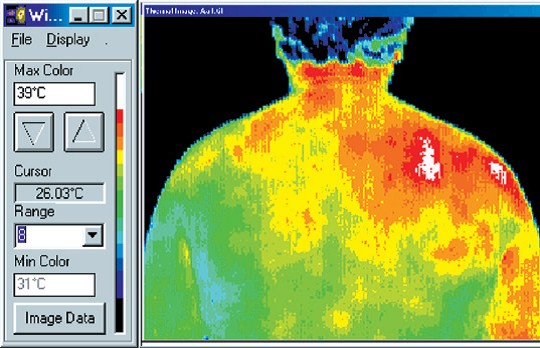Infrared thermal imaging stands out as a cutting-edge technology with a vast array of applications, from industrial diagnostics to medical evaluations. Its ability to detect and measure the infrared energy emitted by objects provides invaluable insights, particularly in the medical field, where it’s becoming a crucial tool in early cancer detection and monitoring. This technology offers a non-invasive, painless diagnostic method, making it an appealing option for individuals concerned about cancer. Let’s delve into how infrared thermal imaging works, its benefits, and its transformative potential across various domains.
Understanding Infrared Thermal Imaging
Infrared thermography, also known as thermal imaging, is a technology that captures and visualizes heat emitted by objects or surfaces in the form of infrared radiation. This process involves the use of thermal cameras or imagers that detect infrared energy and convert it into an image visible to the human eye. These images, called thermograms, display temperature variations across surfaces, allowing for the non-contact measurement of an object’s temperature.
Key aspects of infrared thermography include:
- Non-contact Temperature Measurement: It enables the measurement of temperature from a distance, without needing to physically touch the object. This is particularly useful for inspecting equipment or areas that are inaccessible, hazardous, or moving.
- Visual Representation of Heat: Thermography provides a visual map of temperature differences, with varying colors representing different temperatures. This visual representation helps in identifying hot spots, cold spots, and thermal patterns that may indicate underlying issues.
- Diagnostic Tool: Infrared thermography is widely used as a diagnostic tool in various fields. In maintenance, it can identify overheating parts or electrical issues before they lead to failures. In building inspections, it can reveal heat leaks, moisture intrusion, or insulation defects. In medicine, it can detect abnormal body heat patterns indicative of health issues.
- Preventive Maintenance and Safety: By identifying potential problems before they escalate, infrared thermography plays a crucial role in preventive maintenance strategies for electrical systems, mechanical equipment, and buildings. It also enhances safety by detecting hazardous conditions early.
Overall, infrared thermography is a powerful tool that leverages the heat emitted by objects to provide valuable insights into their condition, performance, and safety, making it indispensable in maintenance, diagnostics, and health screening applications.
At its core, infrared thermal imaging is a technique that captures the invisible infrared radiation emitted by all objects. This technology translates the radiation into thermal images or thermograms, which can be analyzed for various purposes.
- Infrared energy is part of the electromagnetic spectrum and is invisible to the human eye.
- Thermal cameras equipped with special sensors detect this energy and convert it into a visible thermal image.
- These images reveal temperature variations of the object or area being scanned, providing critical data without direct contact.
Key Benefits of Infrared Thermal Imaging
The adoption of infrared thermal imaging across several fields underscores its versatility and efficacy. Its non-invasive nature is particularly beneficial in the medical sector, offering a stress-free alternative to traditional diagnostic methods.
- Enhanced Diagnostic Precision: Thermal imaging can detect subtle changes in body temperature, indicative of early disease stages, including cancer.
- Preventive Maintenance Applications: Beyond medical use, it’s instrumental in preventing costly breakdowns in industrial machinery by identifying overheating components before they fail.
- Energy Efficiency and Insulation Analysis: Homeowners and construction experts use thermal imaging to pinpoint heat leaks, significantly improving a building’s energy efficiency.
- Safety and Surveillance: This technology is also vital in enhancing security, especially in low visibility conditions, and aiding in search and rescue operations.
Innovative Uses of Infrared Thermal Imaging
Infrared thermal imaging is not limited to medical diagnostics and industrial maintenance. Its application in wildlife conservation and agriculture highlights its adaptability and importance in addressing global challenges.
- Wildlife Research and Conservation: Researchers utilize thermal imaging to monitor endangered species, especially in nocturnal studies.
- Agricultural and Environmental Monitoring: It aids in assessing crop health and irrigation needs, contributing to sustainable farming practices.
Understanding the Limitations of Infrared Thermography
While infrared thermal imaging is transformative, acknowledging its limitations ensures realistic expectations and appropriate use.
- Its effectiveness can be influenced by environmental conditions, such as humidity and temperature.
- The accuracy of thermal images depends on the quality of the equipment used.
- Interpretation of thermograms requires
expertise and experience, as incorrect analysis can lead to misdiagnosis or overlook issues.
Future of Infrared Thermal Imaging
The horizon for infrared thermal imaging technology is expansive, with continuous advancements enhancing its accuracy, usability, and application scope.
- Technological innovations are making thermal cameras more compact, affordable, and accessible to a broader audience.
- Future applications may include more advanced medical diagnostics, enhanced environmental monitoring, and innovative uses in smart buildings.
In exploring the realm of infrared thermal imaging, we uncover a technology that transcends its initial industrial applications, proving to be a pivotal tool in medical diagnostics, particularly in the early detection of cancer. Its ability to non-invasively monitor and diagnose, based on the heat signatures of the human body, presents a less intimidating and more efficient alternative to conventional methods. The implications for patients worried about cancer are profound, offering a pathway to early detection and peace of mind without the discomfort and anxiety associated with traditional diagnostic procedures.
Key Takeaways for Infrared Thermal Imaging Insights
- Infrared thermal imaging provides a non-contact, painless method for detecting temperature variations, crucial for early disease detection.
- Its versatility extends beyond medical applications, benefiting industries such as construction, agriculture, and wildlife conservation.
- Continuous advancements in technology are expanding its accessibility and application, promising even greater impacts on healthcare and other fields.
Frequently Asked Questions About Infrared Thermography
1. Can infrared thermal imaging detect cancer? Yes, it can play a role in detecting cancer by identifying abnormal temperature variations in the body, which may indicate the presence of tumors.
2. Is infrared thermal imaging safe? Absolutely. Since it merely captures the infrared radiation emitted by the body or objects, it does not expose individuals to any harmful radiation.
3. How accurate is infrared thermal imaging? While highly effective, the accuracy can vary based on the equipment’s quality and the operator’s expertise. It’s considered a complementary tool rather than a standalone diagnostic method.
4. Can this technology be used at home? With the advent of more compact and affordable thermal imaging cameras, homeowners can use this technology for energy efficiency assessments and basic health checks.
5. What are the future prospects of infrared thermal imaging in healthcare? The future looks promising, with potential advancements in enhancing diagnostic precision, expanding its use in monitoring chronic conditions, and even integrating it with telemedicine platforms for remote healthcare services.
Infrared thermal imaging stands at the intersection of innovation and practicality, offering a glimpse into the unseen world of infrared energy. Its benefits span across various sectors, making it a technology that not only enhances diagnostic capabilities but also contributes to energy efficiency, safety, and environmental conservation. As we continue to explore its potential, infrared thermal imaging is poised to become an even more integral part of our lives, transforming how we approach health, safety, and sustainability.
Mandeville Total Wellness specializes in Nutrition Response Testing, Chiropractic Care and other wellness treatments, dedicated to fostering your body’s natural healing abilities. Our team combines years of expertise in nutrition and chiropractic wellness with a passion for holistic health, offering personalized care tailored to each individual’s needs. Grounded in the belief that true wellness comes from harmony within the body’s systems, we are at the forefront of a health revolution, guiding you towards optimal health. Discover a vibrant, healthier you with Mandeville Total Wellness, your partners in holistic healing.












